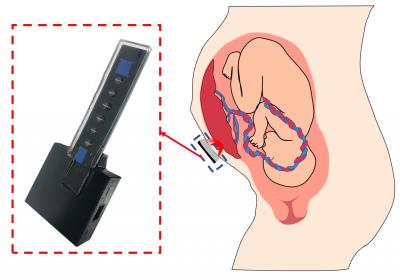NIH researchers pursue innovative method for observing maternal and fetal health during pregnancy
Researchers at the National Institutes of Health have developed a prototype device that could potentially diagnose pregnancy complications by monitoring the oxygen level of the placenta. The device sends near-infrared light through the pregnant person’s abdomen to measure oxygen levels in the arterial and venous network in the placenta. The method was used to study anterior placenta, which is attached to the front wall of the uterus. The researchers described their results as promising but added that further study is needed before the device could be used routinely.
The small study was conducted by Amir Gandjbakhche, Ph.D., of the Section on Translational Biophotonics at NIH’s Eunice Kennedy Shriver National Institute of Child Health and Human Development (NICHD), and colleagues. It appears in Biomedical Optics Express.
The researchers devised mathematical methods to study the passage of light through the skin, abdominal wall and uterine tissue to reach the placenta and calculate its oxygen levels. Currently, the device cannot monitor oxygen in women with a posterior placenta, which is attached to the back wall of the uterus, because the distance is too far for the light to travel. However, anterior placenta is associated with a higher rate of complications than posterior placenta, such as postpartum hemorrhage and an increased need for labor induction or cesarean delivery.
The researchers enrolled 12 pregnant women with an anterior placenta in the study. Of these, five had a pregnancy complication, including hypertension, a short cervix and polyhydramnios (excess amniotic fluid). On average, the women with complications had a placental oxygen level of 69.6%, a difference statistically significant from the 75.3% seen in the healthy pregnancies in the study. The authors see their results as a first step in continuously monitoring placental oxygen levels to assess maternal and fetal health.
###
Media Contact
Robert Bock or Linda Huynh
[email protected]
Related Journal Article
http://dx.





